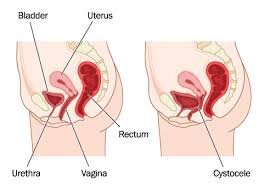Pelvic organ prolapse (POP) is a condition where the pelvic organs, such as the bladder, uterus, or rectum, descend from their normal positions due to weakened pelvic muscles. It can lead to discomfort, urinary issues, and challenges with daily activities. Surgery is often required to correct this condition, but the journey to recovery doesn’t end in the operating room. Pelvic floor physiotherapy plays a crucial role in the postoperative recovery process, helping patients regain strength, function, and overall well-being. In this article, we will explore how pelvic floor physiotherapy aids in recovery from pelvic organ prolapse surgery.
Understanding Pelvic Organ Prolapse and Surgery
Before diving into the benefits of pelvic floor physiotherapy, it’s important to understand what pelvic organ prolapse is and the surgical interventions commonly used to treat it.
Pelvic Organ Prolapse: This condition occurs when the muscles and tissues supporting the pelvic organs weaken, causing one or more organs to drop or press against the vaginal walls. Common types include cystocele (bladder prolapse), rectocele (rectal prolapse), and uterine prolapse.
Surgical Treatment: Surgery for pelvic organ prolapse typically involves repairing the affected tissues and organs, often through vaginal or abdominal approaches. The goal is to restore the normal position of the organs and alleviate symptoms such as discomfort, urinary incontinence, and bowel issues.
While surgery can be effective, it’s not a standalone solution. Postoperative care is essential to ensure a full recovery, and this is where pelvic floor physiotherapy becomes invaluable.
The Role of Pelvic Floor Physiotherapy
Pelvic floor physiotherapy focuses on strengthening the muscles of the pelvic floor, which support the bladder, uterus, rectum, and other pelvic organs. After prolapse surgery, these muscles may be weak, tight, or dysfunctional due to the procedure or the original condition. Pelvic floor physiotherapy aims to address these issues through targeted exercises, education, and manual therapy.
1. Enhancing Muscle Strength and Function
One of the primary goals of pelvic floor physiotherapy after prolapse surgery is to strengthen the pelvic floor muscles. Stronger muscles provide better support to the pelvic organs, reducing the risk of recurrent prolapse or other complications. Physiotherapists teach patients specific exercises, such as Kegels, that target these muscles. Over time, these exercises help in restoring muscle tone and function, aiding in the overall recovery process.
2. Improving Posture and Alignment
Pelvic organ prolapse and the subsequent surgery can affect a patient’s posture and alignment. Poor posture can place additional strain on the pelvic floor, hindering recovery. Pelvic floor physiotherapists assess a patient’s posture and provide guidance on how to maintain proper alignment during daily activities. This not only supports the healing process but also prevents future issues related to pelvic floor dysfunction.
3. Pain Management and Relief
Postoperative pain is common after pelvic organ prolapse surgery. Pelvic floor physiotherapy can help manage and alleviate pain through various techniques, including manual therapy, stretches, and relaxation exercises. By addressing pain early in the recovery process, patients can avoid the development of chronic pain conditions and improve their overall quality of life.
4. Addressing Scar Tissue and Adhesions
Surgical procedures can result in scar tissue and adhesions, which may lead to discomfort, restricted movement, and even dysfunction of the pelvic floor muscles. Pelvic floor physiotherapists are trained to identify and treat these issues using manual therapy techniques, such as myofascial release, to soften and mobilize scar tissue. This can help restore normal tissue function, reduce pain, and improve flexibility.
5. Restoring Bladder and Bowel Function
Pelvic organ prolapse often affects bladder and bowel function, leading to issues such as urinary incontinence or difficulty with bowel movements. Surgery can correct these issues, but the pelvic floor muscles still need to be retrained to function properly. Pelvic floor physiotherapy includes exercises and techniques to help patients regain control over these functions, reducing the risk of postoperative complications.
6. Preventing Recurrence
One of the biggest concerns after prolapse surgery is the possibility of recurrence. While surgery addresses the immediate problem, it’s important to address the underlying issues that led to the prolapse in the first place. Pelvic floor physiotherapy helps strengthen the pelvic muscles, improve posture, and educate patients on lifestyle modifications that can reduce the risk of prolapse recurrence. This proactive approach is key to maintaining long-term pelvic health.
7. Supporting Emotional Well-being
The physical aspects of recovery are important, but so is the emotional well-being of patients. Pelvic organ prolapse and its treatment can be emotionally taxing, leading to feelings of embarrassment, frustration, or anxiety. Pelvic floor physiotherapists often provide a supportive environment where patients can discuss their concerns and receive guidance on managing the emotional challenges of recovery. This holistic approach helps patients feel more confident and empowered during their healing journey.
8. Personalized Care and Education
Every patient’s recovery journey is unique, and pelvic floor physiotherapy offers personalized care tailored to individual needs. Physiotherapists conduct thorough assessments to understand each patient’s specific challenges and goals. They then create a customized treatment plan that includes exercises, manual therapy, and education on lifestyle modifications. This personalized approach ensures that patients receive the care they need to achieve optimal recovery outcomes.
Integrating Pelvic Floor Physiotherapy into Postoperative Care
To maximize the benefits of pelvic floor physiotherapy after pelvic organ prolapse surgery, it’s important for patients to begin physiotherapy as soon as it is medically appropriate. This typically involves a referral from the surgeon or healthcare provider, who can work closely with the physiotherapist to coordinate care.
Early Intervention: Starting pelvic floor physiotherapy early in the recovery process can help prevent complications and promote faster healing. However, it’s important to follow the surgeon’s guidelines regarding the timing of physiotherapy to avoid putting undue stress on healing tissues.
Consistency and Commitment: Pelvic floor physiotherapy is most effective when patients are consistent and committed to their treatment plan. This includes attending regular physiotherapy sessions and performing prescribed exercises at home. Patients should view physiotherapy as an integral part of their overall recovery plan.
Communication and Collaboration: Open communication between the patient, surgeon, and physiotherapist is essential for successful recovery. Patients should feel comfortable discussing any concerns or difficulties they experience during their recovery journey. Collaboration between healthcare providers ensures that the patient receives comprehensive care that addresses all aspects of their recovery.
Conclusion
Pelvic floor physiotherapy is a vital component of the recovery process after pelvic organ prolapse surgery. By strengthening the pelvic muscles, improving posture, managing pain, and addressing other postoperative challenges, physiotherapy helps patients achieve a full and lasting recovery. It also empowers patients with the knowledge and tools they need to maintain their pelvic health in the long term. For anyone undergoing prolapse surgery, integrating pelvic floor physiotherapy into their postoperative care plan is a proactive step toward a healthier, more confident future.











Leave a Reply